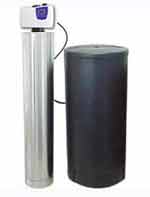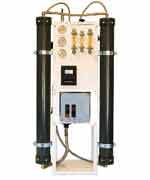Hard water treatment may be required if the water is “hard”
The term “water hardness” originally referred to the ability of water to precipitate soap and form soap scum. Soap is precipitated (or brought to the “surface”) by water containing high levels of calcium and magnesium. The “harder” the water the less soap will dissolve in the water.
In current practice, total hardness is defined as the sum of the concentration of the calcium and magnesium ions, expressed as calcium carbonate. Hardness can be expressed as calcium carbonate in either parts per million (the same as milligrams per liter) or grains per gallon. Since automatic water softeners are rated in grains of hardness removal, this is the more common measurement used by U.S. consumers. One grain of hardness equals approximately 17.1 ppm of calcium carbonate hardness.
Water hardness minerals are commonly treated with a water softener system that uses an ion-exchange resin and regenerates with salt. For residential and commercial applications these are the most effective as they remove the hardness minerals from water. Hard water treatment is common for many people on well water.
There are many devices on the market that purport to eliminate the effects of water hardness by the use of electrical fields, magnetism, catalytic metals and other materials. These are called No-Salt Water Conditioners and do not remove hardness from the water, but treat minerals to prevent scale build-up.
We have sold and tested many types over the last 25 years and the most effective one is the Scale-Stopper Salt-Free Water Conditioner, using a technology called ‘Template Assisted Crystallization' or TAC. This can be a great alternative to water softeners, particularly for eliminating scale build-up in pipes, fixtures, and appliances. The Salt-Free Scale Stoppers are a good solution for how to treat hard water.
Natural waters may range from close to zero hardness to many hundreds of parts per million. In our experience, water over 100 or 150 ppm (approximately 8 – 10 grains/gallon) is hard enough to warrant water softening. When the water hardness exceeds 250 – 300 ppm, a water softener becomes somewhat of a necessity. Otherwise, without hard water treatment the piping systems, water heaters, fixtures and appliances can become scaled up and worn out prematurely. At levels of 100 to 250 ppm (or up to 8 to about 15 grains/ gallon) water softening is an aesthetic improvement, reducing spotting of fixtures and surfaces, and making hair and skin softer.
Softened water saves money by reducing the amount of detergent required for laundry and bathing, and by lowering the amount of energy required in electric and gas water heaters. Soft water leaves skin and hair softer and eliminates the drying effects of hard water minerals on skin and hair. Soft or conditioned water also stops mineral scales from forming in pipes and extends the life of fixtures, appliances and water heaters.
Most facilities such as commercial launderers, hospitals and hotels use water softening to reduce costs and extend the life of equipment and laundered items. Levels of hardness above 100 to 250 ppm, depending on the water chemistry, make water softeners economically feasible. Hard Water Treatment saves piping systems and dramatically extending the life of fixtures, appliances and water heaters.
In some commercial applications, instead of using water softeners and physically removing the calcium and magnesium minerals, phosphate injectors can be used.
Polyphosphates and some ortho-phosphates sequester the hardness minerals and prevent scale formation on pipe walls and in water heaters. No water hardness is removed, but the piping and appliances are spared the effects of hard water.
Also see Salt-Free Water Conditioners, called the Scale-Stopper Salt-Free Water Conditioner.
Need help selecting a system? Fill out our quick and easy Water System Designer Form and get a response in 24 hours or less.
Frequently Asked Questions About Water Softeners
Read what Wikipedia has to say about hard water.
Find out if your water will form scale or not by using our online Langelier Saturation Index calculator.
Stainless Steel Water Softener
Whole House UltraFiltration or Reverse Osmosis Systems
Phosphate Systems for Corrosion Control
Navigating Through Hard Water Challenges: A Curated List of Informative Resources”
-
Get It Straight: Hard Truths About Soft Water
- Link: Clean Water Store Blog
- Description: Dive into this insightful article that demystifies various aspects of soft water, providing readers with a comprehensive understanding of its characteristics, benefits, and underlying science.
-
Ground Water and Drinking Water: Ensuring Safety and Quality
- Link: EPA Ground Water and Drinking Water
- Description: Explore the EPA’s extensive resources on ground and drinking water, offering guidelines, standards, and valuable information to safeguard water quality in the United States.
-
Water Hardness and Alkalinity: A Scientific Perspective
- Link: USGS Water Hardness Information
- Description: The USGS provides a detailed overview of water hardness, exploring its causes, impacts, and geographical distribution across various regions.
-
Private Wells: A Guide to Safe and Healthy Water
- Link: CDC Private Wells
- Description: The CDC offers a robust guide on managing private wells, including essential information on testing, treating, and maintaining well water to ensure safety and health.
-
Well Owner Resources: A Comprehensive Guide for Well Maintenance
- Link: NGWA Well Owner Resources
- Description: NGWA provides a wide array of resources tailored for well owners, covering crucial topics like well maintenance, water testing, and addressing various water-related issues.
-
Hard Water and Water Softening: An In-depth Exploration
- Link: Water Research Center Information on Hard Water
- Description: The Water Research Center offers a thorough exploration of hard water, discussing its impacts, testing methodologies, and various treatment alternatives.









